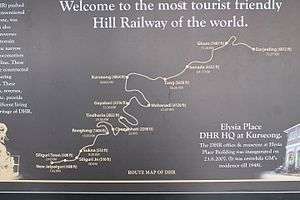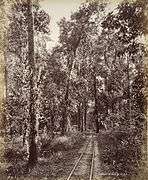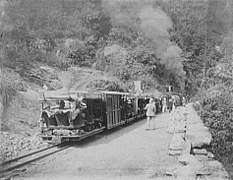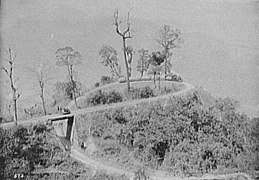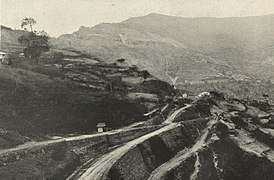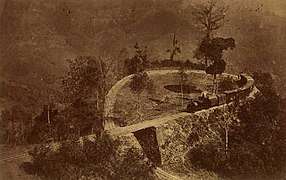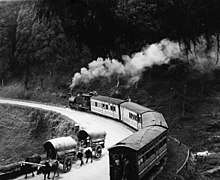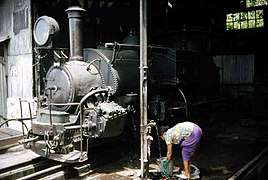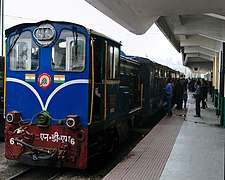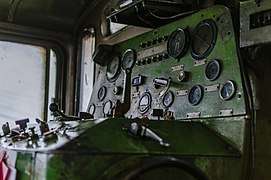Darjeeling Himalayan Railway
| Darjeeling Himalayan Railway | |||||
|---|---|---|---|---|---|
|
Passing a fruit shop in Darjeeling | |||||
| Terminus | Darjeeling | ||||
| Commercial operations | |||||
| Built by | Franklin Prestage | ||||
| Preserved operations | |||||
| Operated by | Northeast Frontier Railway | ||||
| Stations | 14 | ||||
| Length | 88 km | ||||
| Preserved gauge | 2 ft (610 mm) | ||||
| Commercial history | |||||
| Opened | 1879 | ||||
| Preservation history | |||||
| Headquarters | Elysia Place, Kurseong | ||||
| UNESCO World Heritage site | |||||
| Part of | Mountain Railways of India | ||||
| Criteria | Cultural: (ii)(iv) | ||||
| Reference | 944ter-001 | ||||
| Inscription | 1999 (23rd Session) | ||||
| Extensions | 2005, 2008 | ||||
| Area | 5.34 ha (0.0206 sq mi) | ||||
| Buffer zone | 70 ha (0.27 sq mi) | ||||
| Coordinates | 26°40′48″N 88°27′36″E / 26.68000°N 88.46000°ECoordinates: 26°40′48″N 88°27′36″E / 26.68000°N 88.46000°E | ||||
 Location of Darjeeling Himalayan Railway in India | |||||
| |||||
The Darjeeling Himalayan Railway, also known as the DHR or Toy Train, is a 2 ft (610 mm) narrow-gauge railway based on zig zag and loop-line technology which runs between New Jalpaiguri and Darjeeling in the Indian state of West Bengal. Built between 1879 and 1881, with six zig-zags and five loops, the railway is about 88 km (55 mi) long. Its elevation varies from about 100 m (328 ft) at New Jalpaiguri to about 2,200 m (7,218 ft) at Darjeeling. Although four diesel locomotives handle most scheduled service, the daily tourist trains (from Darjeeling to Ghum—India's highest railway station—and the Red Panda, from Darjeeling to Kurseong) and steam-enthusiast specials are hauled by vintage British-built B-Class steam locomotives. The railway's headquarters are in Kurseong.
On 2 December 1999, UNESCO declared the DHR a World Heritage Site.[1] Two more railway lines were later added, and the site became known as the mountain railways of India.
History
Siliguri, at the base of the Himalayas, was connected with Calcutta (now Kolkata) by metre gauge railway in 1878. Between Siliguri and Darjeeling, Tonga services ran on a cart road (present-day Hill Cart Road).[2] Franklin Prestage, an agent of the Eastern Bengal Railway, approached the government with a proposal to lay a steam tramway from Siliguri to Darjeeling.[2] Ashley Eden, lieutenant governor of Bengal, formed a committee to assess the project's feasibility. The proposal was accepted in 1879 after a positive report by the committee,[2] and construction began that year.
Gillanders Arbuthnot and Company was hired for the construction, and by March 1880 the line extended to Tindharia. Lord Lytton, the first viceroy to visit Darjeeling, rode to Tindharia on the train.[2] The stretch from Siliguri to Kurseong opened on 23 August 1880, and from Siliguri to Darjeeling on 4 July 1881.[3] The company's name was changed to Darjeeling Himalayan Railway Company.
Although the railroad originally followed Hill Cart Road, the steepness of the road was more than the locomotives could handle in some areas. In 1882, four loops and four reverses (zig-zags) were built between Sukna and Gayabari to ease the gradient.[4] The line was extended by a quarter-mile to Darjeeling Bazar in 1886.[3] The Darjeeling station was renovated in 1891 and Kurseong got a new station building and storage shed in 1896,[4] but the railway was impacted by an 1897 earthquake and a major cyclone in 1899.[4]
By 1909–1910, the DHR carried 174,000 passengers and 47,000 tons of goods annually.[4] The first bogie carriages entered service, replacing basic four-wheel carriages. DHR extension lines were built to Kishanganj in 1914 and Gielkhola in 1915.[3] At Tindharia, the railway works were relocated from behind the locomotive shed to a larger site.[4]
The Batasia Loop was constructed in 1919, creating easier gradients on the ascent from Darjeeling.[4] The DHR began facing competition from buses operating on the Hill Cart Road which took less time than the railway to reach Darjeeling. In 1934, a major earthquake in Bihar shook all of Northeast India. Many buildings in Darjeeling were heavily damaged and the railway was also affected, although it soon recovered and played a vital role in transporting repair materials.[4] During World War II, the DHR transported military personnel and supplies to the camps around Ghum and Darjeeling.[4]
In 1951, the railway was purchased by the Indian government and was absorbed into the government railway organisation[4] before it was managed by the Assam Railway. Assam Railway (including the DHR) became part of the North Eastern Railway zone in 1952,[4] and part of Indian Railways' Northeast Frontier Railway zone six years later.[4] In 1962, the railway was realigned at Siliguri and extended by nearly 4 miles (6 km) to New Jalpaiguri (NJP) to meet the new broad-gauge line there.[4] The extension began freight service that year, and passenger service in 1964. The locomotive shed and carriage depot at Siliguri Junction were moved to NJP.
The railway was closed for 18 months during the Gorkhaland hostilities in 1988 and 1989.[4] It was declared a World Heritage Site by UNESCO in 1999.[5]
Operators
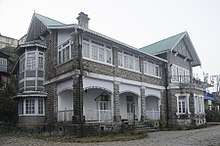
The DHR and its assets, including the stations, line and vehicles, is owned by the government of India and entrusted to the Ministry of Railways. The Northeast Frontier Railway documented the railway in a comprehensive register, and handles its day-to-day maintenance and management. Several programs, divisions and departments of Indian Railways are responsible for operating, maintaining and repairing the DHR. It is protected by the 1989 Railway Act and the stipulations governing public property.[6]
Rolling stock
Present
Steam
All the steam locomotives currently in use on the railway are B-Class, built by Sharp, Stewart and Company and later the North British Locomotive Company between 1889 and 1925. A total of 34 were built, but by 2005 only 12 were still in use or being repaired by the railway.
In 2002, No. 787 was rebuilt for oil firing on the same principle as that used on Nilgiri Mountain Railway No. 37395. A diesel-powered generator was fitted to operate the oil burner and an electrically-driven feed pump, and a diesel-powered compressor was fitted to power the braking system. The locomotive was also fitted with a feedwater heater. The rebuild dramatically changed its appearance. Trials of the refitted locomotive were disappointing, and it never entered regular service; in early 2011, it was in the Tindharia Works awaiting re-conversion to coal-firing.
In March 2001, No. 794 was transferred to the Matheran Hill Railway for a "joy train"[7] (a steam-hauled tourist train) on that railway. It entered service there in May 2002.
- A-Class locomotive
.jpg) B-Class locomotive
B-Class locomotive- Loading coal into a locomotive
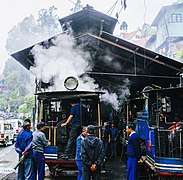 Daily maintenance
Daily maintenance
Diesel
Four diesel locomotives are in use: Nos. 601–2, 604 and 605 of the NDM6 class, transferred from the Matheran Hill Railway.
Past
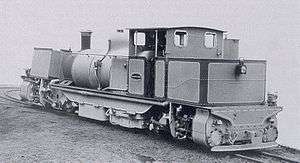
The DHR purchased the third Garratt locomotive built, a D Class 0-4-0+0-4-0, in 1910. Only one DHR steam locomotive has been taken out of India: No. 778 (originally No. 19). After many years out of use at the Hesston Steam Museum, it was sold to an enthusiast in the UK and restored to working order. Now on a private railway (the Beeches Light Railway in Oxfordshire), it has run on the Ffestiniog Railway, the Launceston Steam Railway and the Leighton Buzzard Light Railway.
Route
| Darjeeling Himalayan Railway | ||||||||||||||||||||||||||||||||||||||||||||||||||||||||||||||||||||||||||||||||||||||||||||||||||||||||||||||||||||||||||||||||||||||||||||||||||||||||||||||||||||||||||||||||||||||||||||||||||||||||||||||||||||||||||||||||||||||||||||||||||||||||||||||||||||||||||||||||||||||||||||||||||||||||||||||||||||||||||||||||||||||||||||||||||||||||||||||||||||||||||||||||||||||||||||||||||||||||||||||||||||||||||||||||||||||||||||||||||||||||||||||||||||||||||||||||||||||||||||||||||||||||||||||||||||||||||||||||||||||||||||||||||||||||||||||||||||
|---|---|---|---|---|---|---|---|---|---|---|---|---|---|---|---|---|---|---|---|---|---|---|---|---|---|---|---|---|---|---|---|---|---|---|---|---|---|---|---|---|---|---|---|---|---|---|---|---|---|---|---|---|---|---|---|---|---|---|---|---|---|---|---|---|---|---|---|---|---|---|---|---|---|---|---|---|---|---|---|---|---|---|---|---|---|---|---|---|---|---|---|---|---|---|---|---|---|---|---|---|---|---|---|---|---|---|---|---|---|---|---|---|---|---|---|---|---|---|---|---|---|---|---|---|---|---|---|---|---|---|---|---|---|---|---|---|---|---|---|---|---|---|---|---|---|---|---|---|---|---|---|---|---|---|---|---|---|---|---|---|---|---|---|---|---|---|---|---|---|---|---|---|---|---|---|---|---|---|---|---|---|---|---|---|---|---|---|---|---|---|---|---|---|---|---|---|---|---|---|---|---|---|---|---|---|---|---|---|---|---|---|---|---|---|---|---|---|---|---|---|---|---|---|---|---|---|---|---|---|---|---|---|---|---|---|---|---|---|---|---|---|---|---|---|---|---|---|---|---|---|---|---|---|---|---|---|---|---|---|---|---|---|---|---|---|---|---|---|---|---|---|---|---|---|---|---|---|---|---|---|---|---|---|---|---|---|---|---|---|---|---|---|---|---|---|---|---|---|---|---|---|---|---|---|---|---|---|---|---|---|---|---|---|---|---|---|---|---|---|---|---|---|---|---|---|---|---|---|---|---|---|---|---|---|---|---|---|---|---|---|---|---|---|---|---|---|---|---|---|---|---|---|---|---|---|---|---|---|---|---|---|---|---|---|---|---|---|---|---|---|---|---|---|---|---|---|---|---|---|---|---|---|---|---|---|---|---|---|---|---|---|---|---|---|---|---|---|---|---|---|---|---|---|---|---|---|---|---|---|---|---|---|---|---|---|---|---|---|---|---|---|---|---|---|---|---|---|---|---|---|---|---|---|---|---|---|---|---|---|---|---|---|---|---|---|---|---|---|---|---|---|---|---|---|---|---|---|---|---|---|---|---|---|---|---|---|---|---|---|---|---|---|---|---|---|---|---|---|---|---|---|---|---|---|---|---|---|---|---|---|---|---|---|---|---|---|---|---|---|---|---|---|---|---|---|---|---|---|---|---|---|---|---|---|---|---|---|---|---|---|---|---|---|---|---|---|---|---|---|---|---|---|---|---|---|---|---|---|---|---|---|---|---|---|---|---|---|---|
| ||||||||||||||||||||||||||||||||||||||||||||||||||||||||||||||||||||||||||||||||||||||||||||||||||||||||||||||||||||||||||||||||||||||||||||||||||||||||||||||||||||||||||||||||||||||||||||||||||||||||||||||||||||||||||||||||||||||||||||||||||||||||||||||||||||||||||||||||||||||||||||||||||||||||||||||||||||||||||||||||||||||||||||||||||||||||||||||||||||||||||||||||||||||||||||||||||||||||||||||||||||||||||||||||||||||||||||||||||||||||||||||||||||||||||||||||||||||||||||||||||||||||||||||||||||||||||||||||||||||||||||||||||||||||||||||||||||
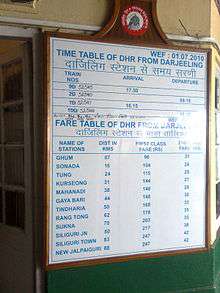
The line follows Hill Cart Road, which is part of National Highway 110. The track is on the roadside for long stretches, and both track and road might be blocked by a rockslide. Since a length of the road is flanked with buildings, the railway line often resembles urban tramway tracks. To warn pedestrians and drivers of an approaching train, engines are equipped with very loud horns which train drivers sound their horn almost constantly.
A major difficulty faced by the DHR was the steepness of the terrain. Loops and zig-zags were incorporated along the route to achieve a comfortable gradient. When the train moves forward, reverses and then moves forward again (climbing a slope while doing so), it gains altitude along the side of the hill.
Stations
- New Jalpaiguri (NJP): New Jalpaiguri was the terminus of the 1964 southern extension to meet the new broad gauge line to Assam.
- Siliguri Town: The line's original southern terminus
- Siliguri Junction: Siliguri Junction became a major station when a new line was built to Assam during the early 1950s. From NJP to Siliguri Junction, the 1,676-millimetre (5 1⁄2 ft) broad-gauge line runs parallel to the DHR.
- Sukna: This station begins a change in the landscape, from flat plains to the wooded lower slopes of the mountains. The gradient of the railway changes dramatically. Loop 1, in the woods above Sukna, was removed after flood damage in 1991 and the site is obscured by the forest.
- Rongtong: A short distance above Rongtong is a water tank, better positioned than at the station in terms of water supply and distance from other water tanks. Loop 2 was removed in 1942 after flood damage. A new reverse, No. 1, was added for the longest reverse run. Loop No. 3, at Chunbatti, is now the lowest loop. Reverses No. 2 and 3 are between Chunbatti and Tindharia.
- Tindharia: Workshops are below the station. An office for engineers and a large locomotive shed are on a separate site. Above the station are three sidings, used to inspect the carriage while the locomotive is changed before the train continues towards Darjeeling.
- Loop 4: Known as Agony Point, the loop has the line's tightest curve.
- Gayabari
- Reverse No. 6: The last reverse on the climb
- Mahanadi
- Kurseong: Although a shed and several sidings are adjacent to the main line, the station proper is a dead end. Darjeeling-bound trains must back out of the station (across a busy road junction) to continue the climb. The station houses a one-room DHR museum with several exhibits, artifacts and vintage photos. At the centre of the room, a wooden showcase contains several old newspaper articles about the railway.[8] After the station, the railway passes a busy shopping area.
- Tung
- Sonada
- Rangbul
- Jorebungalow: A storage point for tea bound for Kolkata, it connects Darjeeling to the rest of India.
- Ghum: Ghum, the line's summit, is India's highest station. The station building includes a first-floor museum, with larger exhibits in the old goods yard.
- Batasia Loop: The loop is 5 km (3.1 mi) from Darjeeling, below Ghum. There is a memorial to the Gorkha soldiers of the Indian Army who sacrificed their lives after Indian independence in 1947. The loop has a panoramic view of Darjeeling, with Kangchenjunga and other snow-capped mountains in the background.
- Darjeeling: The terminus of the line
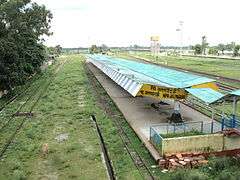 New Jalpaiguri
New Jalpaiguri- Siliguri Junction
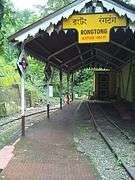 Rongtong
Rongtong- Sukna
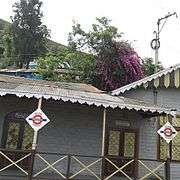 Tindharia
Tindharia- Mahanadi
 Sonada
Sonada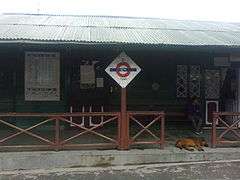 Tung
Tung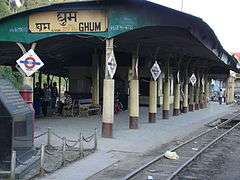 Ghum
Ghum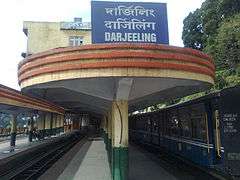 Darjeeling
Darjeeling
In popular culture
The Earl of Ronaldshay described a journey on the railway in the early 1920s:
Siliguri is palpably a place of meeting ... The discovery that here the metre gauge system ends and the two foot gauge of the Darjeeling-Himalayan railway begins, confirms what all these things hint at ... One steps into a railway carriage which might easily be mistaken for a toy, and the whimsical idea seizes hold of one that one has accidentally stumbled into Lilliput. With a noisy fuss out of all proportion to its size the engine gives a jerk — and starts ... No special mechanical device such as a rack is employed — unless, indeed, one can so describe the squat and stolid hill-man who sits perched over the forward buffers of the engine and scatters sand on the rails when the wheels of the engine lose their grip of the metals and race, with the noise of a giant spring running down when the control has been removed. Sometimes we cross our own track after completing the circuit of a cone, at others we zigzag backwards and forwards; but always we climb at a steady gradient — so steady that if one embarks in a trolley at Ghum, the highest point on the line, the initial push supplies all the energy necessary to carry one to the bottom.[9]
The trip to Darjeeling by rail has changed little since that time, and continues to delight travelers and rail enthusiasts. The Darjeeling Himalayan Railway Society is a preservation and support group.[10] Like tea and the Ghurka culture, the DHR has become an essential feature of the landscape and an enduring part of Darjeeling's identity.[11]
Film
Several films have depicted the railway. Protagonist Rajesh Khanna sings "Mere Sapno Ki Rani" to heroine Sharmila Tagore, who is on the train, in the 1969 film Aradhana.[12][13] Other films which include the railway are Barfi!, Parineeta and Raju Ban Gaya Gentleman.
Television
The BBC made a series of three documentaries[14] on the mountain railways of India, which was first broadcast in February 2010. The first episode covers the Darjeeling Himalayan Railway, the second the Nilgiri Mountain Railway, and the third the Kalka–Shimla Railway. The documentaries, directed by Tarun Bhartiya, Hugo Smith and Nick Mattingly, were produced by Gerry Troyna. The documentary on Darjeeling Himalayan Railway was directed by Tarun Bhartiya. The series won the UK Royal Television Society Award in June 2010.[15]
See also
References
- ↑ "Mountain Railways of India". UNESCO World Heritage Centre. Retrieved 2006-04-30.
- 1 2 3 4 "DHR History". darjeelingnews.net. Darjeelingnews. Retrieved 24 February 2007.
- 1 2 3 "DHR and Its Development". About DHR,dhr.in. Darjeeling Himalayan Railway, NF Railway, India. Retrieved 24 February 2007.
- 1 2 3 4 5 6 7 8 9 10 11 12 13 Whittle, Paul; Terry Martin. "A Brief History of the DHR". History and A Trip Up the Line. Darjeeling Himalayan Railway Society. Archived from the original on 8 February 2007. Retrieved 24 February 2007.
- ↑ "Mountain Railways of India". UNESCO World Heritage Centre. Retrieved 30 April 2006.
- ↑ "1989 Railway Act" (PDF). Rct.indianrail.gov.in. Retrieved 2012-10-05.
- ↑ "Darjeeling Himalayan Railway". Hill Railways. Indian Railways Fan Club. Retrieved 3 September 2008.
- ↑ "Darjeeling Himalayan Railway Museum Kurseong". Darjeeling Tourism. Retrieved 24 February 2017.
- ↑ The Earl of Ronaldshay, Lands of the Thunderbolt. Sikhim, Chumbi and Bhutan (London: Constable & Company), 1923, pp 10-12
- ↑ "Welcome to the DHRS". Darjeeling Himalayan Railway Society. Archived from the original on 28 February 2007. Retrieved 2007-03-09.
- ↑ "The Darjeeling Himalayan Railway". Indian HillRailways. BBC. Retrieved 2012-08-14.
- ↑ Mahalingam, Sudha (March 2001). "Darjeeling: Where the journey is the destination". Travelogues. Outlook Traveller. Outlook Publishing (India) Private Limited. Archived from the original on 10 December 2006. Retrieved 2007-03-09.
- ↑ "Darjeeling Toy Train". Train Tourism in India. IndiaLine. Retrieved 2007-03-09.
- ↑ "Indian Hill Railways". BBC. Retrieved 2010-02-28.
- ↑ "Documentary on Hill railways of India bags UK award". Express India. Archived from the original on 10 October 2012. Retrieved 19 September 2010.
Further reading
- Badawy, Emile D.; Crow, Lindsay, eds. (1999). The Darjeeling Himalayan Railway: A photographic profile – 1962–1998. Studfield, Vic, Australia: Train Hobby Publications. ISBN 1876249250.
- Barrie, David; Charlesworth, David (2005). Going Loopy. Darjeeling Mail extra, no. 2. Doncaster, South Yorkshire, UK: Darjeeling Himalayan Railway Society. ISBN 0954160223.
- Cable, Bob (2011). Darjeeling Revisited: A journey on the Darjeeling Himalayan Railway. Narrow Gauge Branch Lines series. Midhurst, West Sussex, UK: Middleton Press. ISBN 9781908174093.
- Krieg, Allan D (January 1946). "The Darjeeling Himalayan: take a ride into the clouds on a two-foot gauge railway with which many of our GI's have become familiar while in India". Trains. 6 (3): 42–49. ISSN 0041-0934. OCLC 31296210.
- Martin, Terry (2000). Halfway to Heaven. Chester, Cheshire, UK: RailRomances. ISBN 1900622033.
- Martin, Terry (2006). The Iron Sherpa: the story of the Darjeeling Himalayan Railway, 1879-2006. 1. Chester, Cheshire, UK: RailRomances. ISBN 1900622106.
- Martin, Terry (2010). The Iron Sherpa: the history of the Darjeeling Himalayan Railway. 2. Chester, Cheshire, UK: RailRomances. ISBN 9781900622127.
- Smith, J Burlington; Lasell, Eldridge L; Lasell, David; Lasell, Diane L; Lasell Iltis, Sarah; Iltis, Ron (c. 1911). The Darjeeling Himalayan Railway: an illustrated guide to the railway & Darjeeling. Middlesbrough, England: Hood & Co. OCLC 43293759.
- Thomas, John (2010). Himalayan Journey. London: British Overseas Railways Historical Trust. ISBN 9781901613032.
- Thornton Jones, Frank (2003). Darjeeling Christmas, 1945: the Darjeeling photographs of Frank Thornton Jones. Darjeeling Mail extra, no. 1. Nottinghamshire: Darjeeling Himalayan Railway Society. ISBN 0954160215.
- Wallace, Richard (2009). The Darjeeling Himalayan Railway: A Guide to the DHR, Darjeeling and its Tea (2nd ed.). Kenilworth, Warwickshire, UK: Friends of the Darjeeling Himalayan Railway. ISBN 9780954160234.
- Darjeeling and its Mountain Railway. Kolkata, India: Nava Udyog. 2002. ISBN 8185971951. (Facsimile reprint. Originally published: Kurseong: Darjeeling Himalayan Railway, 1921.)
- Darjeeling Himalayan Railway: World Heritage Area: bringing people and their heritage together. National Rail Museum & UNESCO Stakeholder Workshop report, 11th–18th January 2002. New Delhi: National Rail Museum. 2002. OCLC 84649417.
- The Darjeeling Himalayan Railway: Illustrated Guide for Tourists. Bath, Somerset, UK: Pagoda Tree Press. 2004. ISBN 1904289037. (Facsimile reprint of the 1st edition, originally published in 1896 by the Darjeeling Himalayan Railway Company, Darjeeling, India.)
External links
| Wikimedia Commons has media related to Darjeeling Himalayan Railway. |
- Darjeeling Himalayan Railway Society site
- List of all trains at Darjeeling Railway Station
- More pictures of Darjeeling and the railroad at the University of Houston Digital Library
- Darjeeling Himalayan Railway BBC video documentary
